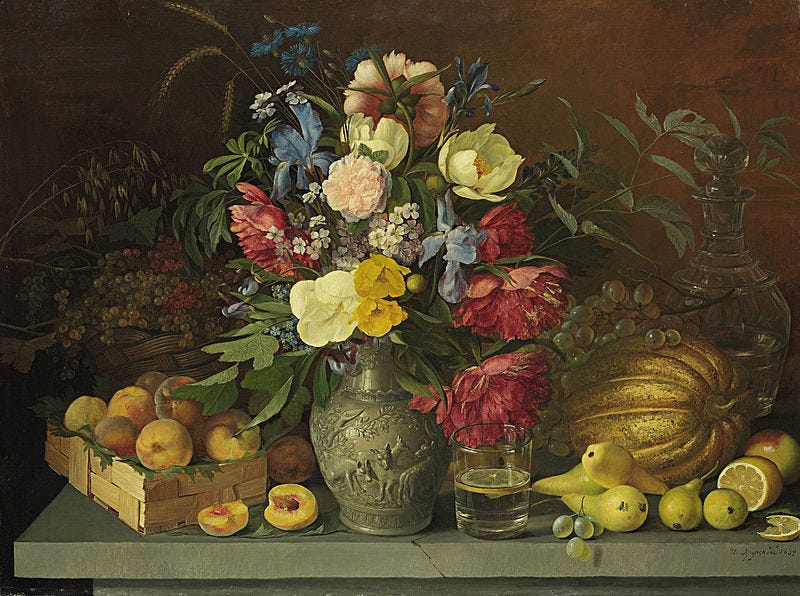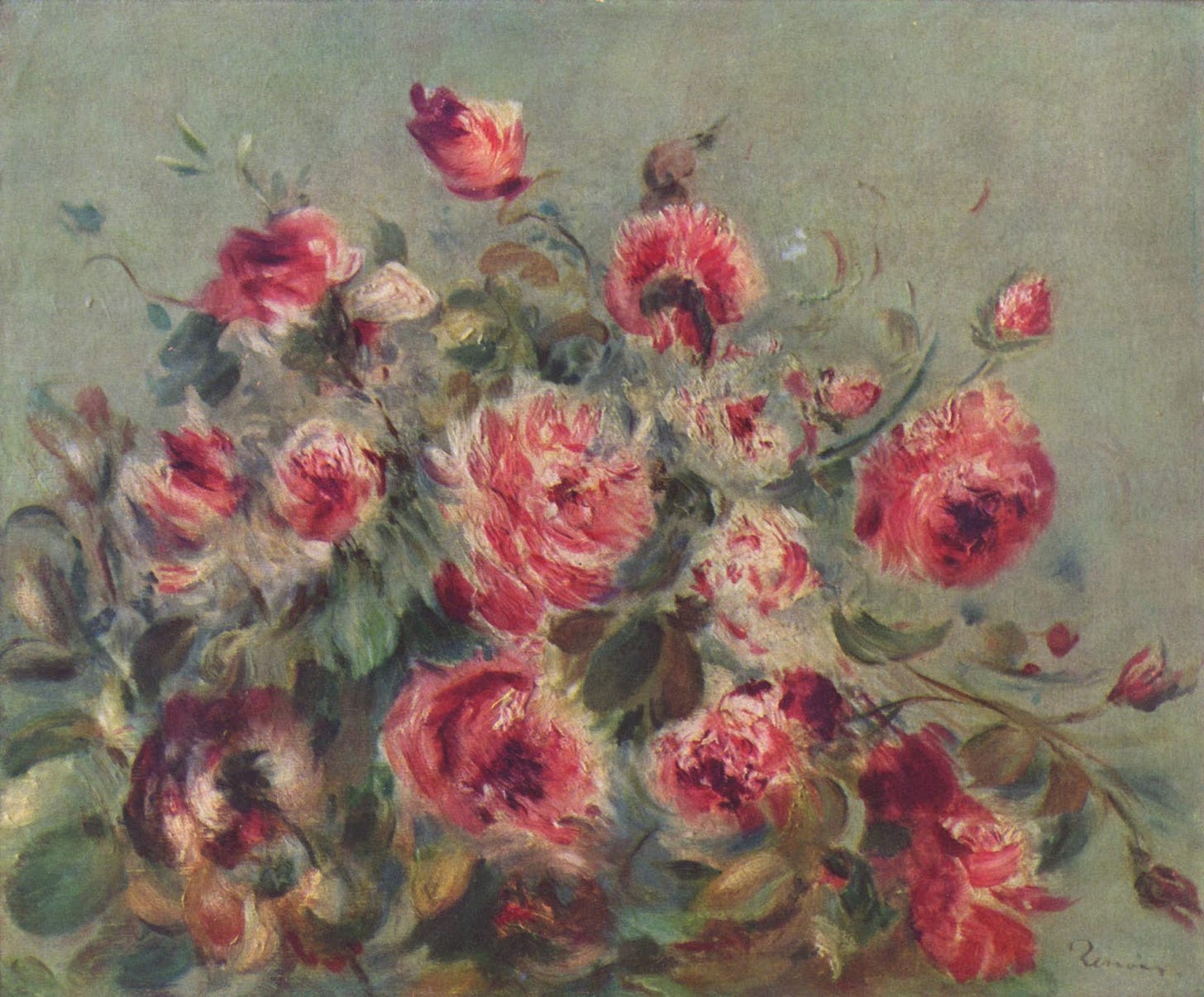What's The Point of Still Life?
Just flowers and vases or there's more to it?
Still life is the name given to a painting whose primary subject is mostly an inanimate object; Fruit, flowers, books, glasses, jewelry - everything in the painter's room, apart from the painter himself, could qualify as still life.
Still life is traditionally considered the lowest form of painting. It may seem like a reasonable claim to make. Mainly because throughout history, still life was sometimes used as an exercise for the painter or perhaps as a mere decoration object; Not an end in itself, not the highest goal of painting, but rather the first step towards it.
Is there more to still life painting? Is its traditional place as the last in the hierarchy of genres justified? Is it even art or only part art? I will attempt to answer all of these questions.
Is It Art?
As I have discussed in previous essays, art is a re-creation of reality according to the artist's metaphysical value judgments. Let us review a few examples to see whether this definition applies to still life.
(Bouquet of Flowers in an Urn, Jan van Huysum, 1724)
This magnificent creation by Jan van Huysum (1682-1749) was the epitome of still life. Huysum specialized in still life. He wanted to achieve absolute perfection, which clearly shows. For Huysum, still life was the highest form of art. He showed incredible attention to every little detail. Every flower was carefully placed exactly where he wanted it to be. This covers the "recreating of reality" aspect of the art.
What about metaphysical value judgments? The dutch still life was always filled with symbolism, talking about emotions and ideas. The beautiful blossom of the flowers in the center implies a positive view of life. It implies that the painter thinks it is possible to "blossom" in life. If he were only to show dead flowers, it would be evident that the painter has a "pessimistic" (to say the least) view of life. Despite the great blossom in the center, we see the flowers decaying on the left side. This decay symbolizes the cycle of life.
It is important to note that the format of still life limits the scope of the possible recreation and concretization of metaphysical values. Because the genre is limited to ordinary inanimate objects, the value concretization has to be made via implicit methods such as symbolism. Whether the concretization of value is explicit or implied, this should not diminish the value of the art. However, it can make it hard to find these values, and sometimes they are entirely nonexistent. The border between art, and semi-art, can get blurry in still life. Getting the most value from a still life may require extensive background knowledge.
Nevertheless, nothing fundamental about the nature of the genre itself prevents it from being an art form. Frequently, many artists did not mean for their still life works to be published, let alone to hang in a museum. This is also something that should be taken into account when judging a still life.
Is The Place of Still Life In The Genre Hierarchy Justified?
Mostly it is justified. As I alluded to, by its nature, still life is a limited genre. It simply cannot compete with full-scale art, such as Historical paintings or landscapes. Still life painting is a unique genre in the hierarchy because traditionally (most likely it is the historical reason for its place in the hierarchy), still life was used as an exercise for the artist. One of the earliest exercises for a beginning painter is to draw accurate still life. Still life helps teach a painter how to get the lighting right, proportions, composition, perspective, and texture. So traditionally, art scholars viewed still life as a crucial first step in the painter's development, but as soon as he continues to develop, he should move on to figure painting. So when viewing still life as a whole genre in that perspective, it makes sense to see it as the lowest genre in the hierarchy. A hierarchy must narrow down as it progresses. Almost all painters start with still life, a few are talented landscapists, and of course, only a few are exceptional in historical paintings. So from the perspective of the genre's skill requirements, it does make sense to place still life at the bottom.
Is It Right to View The Genres As a Hierarchy?
(Flowers and fruits, Jan Chrucki, 1839)
When engaging in the debate about the place of still life in the genre hierarchy, the question arises of whether it is even correct to view the genres in terms of a linear hierarchy. As I discussed in the essay about landscapes during the 19th Century, a shift occurred in the hierarchy. The landscape received a more prominent place among the highest genres. This shift was only possible in earlier centuries because academic traditions and rigid rules ruled the art world with an iron fist.
The hierarchy can have an oppressing effect on aspiring painters. If a revolutionary like Casper David Friedrich lived in the 16th Century, he could have never achieved prominence through his landscape paintings. If a painter wants to be an expert on fruit paintings (and he didn't live in the Netherlands, where it was considered a higher genre), he might have never been able to have a successful career, regardless of his technical skill level.
The hierarchy does exist on a metaphysical level; the possibilities are more extensive in a landscape painting than in a still life. But that does not mean that it's "wrong" to paint still life solely. Values are personal, and every person holds different values in different hierarchies, and that's completely fine.
To conclude, on a metaphysical level, it is correct to see still life as holding less potential for achieving the most profound art experience. However, from a personal perspective, there's no reason to view the art genres as a hierarchy. The difference is the same as between a symphony and a quartet. There are some beautiful and very powerful quartets, but a symphony has a higher potential because it is not limited to 4 instruments.
Source for Relaxation
(Still Life, Roses of Wargemont, Pierre-Auguste Renoir, 1882)
One day, while painting some roses in a green vase, Renoir confided to his friend Georges Riviere: "It gives my brain a rest, painting flowers. I don't feel the same tension as when I have a model in front of me. When I paint flowers, I use colors and try out values boldly without worrying about wasting a canvas. I wouldn't dare to do it with a figure; I'd be afraid of spoiling the whole thing." [1]
This quote touches on a very rarely discussed point about painting: painting figures is stressful. There's a constant worry about them moving, about the limited time the painter has, about the money it costs, about messing it up. (The same also applies to landscapes, for example, the weather constantly changes) But with still life, it's just the artist with the flowers. There's zero stress involved in the process. This fact makes still life a much more relaxing experience for the artist. It can serve as an escape from the stressful job of painting figures and landscapes. This is another vital function of still life. It gives the painter the energy to deal with his more complex projects.
Conclusion
(Flowers at the Window of the Harem, Francesco Hayez, the first half of the 19th Century)
Still life is integral to a painter's life. Most of the time, it is where a painter starts his journey. It is an essential exercise that enables the artist to understand basic technical principles that he can apply to make much better art as a whole. Some stunning and lively works of still life can bring much joy to the viewer and the artist himself. It is a much smaller scale but filled with technical ability and passion. Most of the time, a still life is an overture for the great full-scale pictures that an aspiring painter shall create. It is fascinating to go back to look at where a great painter started. Mostly it will be a seemingly simple vase, but that vase enabled this to-be great artist to reach the summits that he may reach the heights of his career.
---
[1] - Renoir - His Life And Work - Francois Fosca, p.196.






Well-written, thought-provoking article. I learned something new. Keep 'em coming!